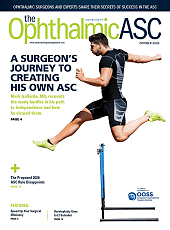Astellas Pharma Inc. announced the first results from the open-label extension trial of the phase 3 GATHER2 study, which demonstrated monthly treatment with Izervay (avacincaptad pegol intravitreal solution) in patients with geographic atrophy (GA) secondary to age-related macular degeneration (AMD) continued to reduce GA lesion growth for up to 3.5 years, with earlier intervention resulting in greater protection of retinal tissue area. Izervay was well tolerated, with no cases of retinal vasculitis or occlusive vasculitis. These findings, which indicate a cumulative treatment benefit with Izervay, were presented at the annual meeting of the American Academy of Ophthalmology (AAO) during the Retina Subspeciality Day in Orlando, Florida, the company said in a press release.
During the 18-month open-label extension (OLE) trial, GA patients who previously completed the GATHER2 study switched from Izervay monthly (EM) or every-other-month (EOM) treatment to Izervay EM, or from sham to Izervay EM.
In the OLE study, disease progression, as measured by mean change in GA lesion growth area was reduced by 40.5% from month 24 (mm2/year) vs projected sham in participants who switched from Izervay EM or EOM to Izervay EM at 3.5 years, and by 37% vs projected sham in the Izervay EM group who previously received sham (p<0.001 for each). Earlier intervention with Izervay consistently resulted in greater protection of retinal tissue area: 2.92 mm2 in the group that switched from Izervay EM or EOM to Izervay EM at 3.5 years and 1.83 mm2 in participants treated with Izervay EM following sham. Izervay was well-tolerated with no new safety signals, no cases of retinal vasculitis or occlusive vasculitis, and no increased risk of intraocular inflammation, the company said.
"The first reported findings from this open-label extension study corroborate the favorable efficacy and safety outcomes previously demonstrated in the 2-year GATHER2 trial," said Arshad M. Khanani, MD, MA, FASRS, Director of Clinical Research at Sierra Eye Associates, Clinical Professor at University of Nevada, Reno, Nevada, in the press release. "Izervay maintains a consistent safety profile and is associated with meaningful reduction in disease progression over time, with the most pronounced benefits observed in patients who initiated treatment at an earlier stage."
A separate real-world study highlighted treatment patterns and safety of Izervay in patients with GA (n=10,181 patients, 13,391 eyes) treated in routine clinical practice. Based on data from the American Academy of Ophthalmology IRIS Registry (Intelligent Research In Sight), this observational analysis included data from US patients who received Izervay during its first year of approval by the US Food and Drug Administration (FDA). This retrospective study found no new safety signals and low rates of discontinuation, supporting the safety and tolerability of Izervay, the company said.
Key real-world study results include:
-
In patients who received [Izervay/ACP] at least twice, the mean interval between injections per patient eyes (n=11,799) was 7.0 weeks
-
While nearly 9 in 10 patients (87.1%) had GA in both eyes, 68.5% received Izervay in one eye
-
22.7% of patient eyes received anti-VEGF therapy in addition to Izervay, of which nearly 90% had previously been on anti-VEGF treatment
-
Overall, 3.6% of patients (2.9% of eyes) experienced any adverse event (AE) during the 25-week study follow-up period, for an event rate of 103 per 10,000 Izervay injections
Another Astellas study at AAO 2025 examined the relationship between structure and function in GA by analyzing ellipsoid zone (EZ) integrity and low luminance deficit (LLD) in eyes with GA treated with Izervay. This post hoc analysis of pooled 18-month data from the GATHER1 and GATHER2 studies demonstrated a structure-function link in GA between photoreceptor health, measured by EZ integrity, and visual function, captured by LLD. Treatment with Izervay slowed progressive loss of photoreceptor signal intensity in the EZ compared to sham over 18 months, particularly in eyes with greater baseline LLD, ie, more severe disease.
According to the company, the findings support the structure-function link between EZ integrity and LLD as biomarkers to help measure GA progression and the impact of treatment. The results also suggest LLD may be a better indicator of visual function in GA than best-corrected visual acuity (BVCA).
Izervay is approved for the treatment of GA in the United States, Australia and conditionally in Japan.








